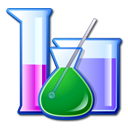In the previous post we discussed about what is matter , what is it made up of , states of matter & changing state of matter.
In this post we will discuss few chemistry terms for change of phase or a state to another.
Generally, solids are more dense than liquids because their molecules are closer together. The freezing process compacts the molecules into a smaller space.
There are always exceptions in science. Water is special in many sense. It has more space between its molecules when it is frozen. The molecules organize in a specific arrangement that takes up more space than when they are all loose in the liquid state. Because the same number of molecules take up more space, solid water is less dense than liquid water.
Solid to Liquid Change Is : Melting
Liquid To Gas : Boiling (Or Vaporization)
Gas To Liquid Change : Condensation
Liquid To Solid : Freezing
Solid To Gas : Sublimation
Gas To Solid : Deposition
An easiest example of sublimation might be dry ice. Dry ice is solid carbon dioxide (CO2). Amazingly, when you leave dry ice out in a room, it just turns into a gas. Have you ever heard of liquid carbon dioxide? It can be made, but not in normal situations. Coal is another example of a compound that will not melt at normal atmospheric pressures. It will sublimate at very high temperatures.
An example of deposition is those little frost crystals that build up on plants when water vapor from the air becomes a solid on the leaves of plants.
Gaseous To Plasma :
[Image Source : chem4kids.com]
Let’s take an example of gas like neon (Ne). Which we want to convert to a plasma state. To do so we need gas to be ionized so that its electrons can be separated from atoms. Electrons have a negative charge. Eventually, you’ll have groups of positively and negatively charged particles in almost equal concentrations. They wind up in a big plasma ball. Because the positive and negative charges are in equal amounts, the charge of the entire plasma is close to neutral. Neutral happens when a whole bunch of positive particles cancel out the charges of an equal bunch of negatively charged particles.
Plasma can be made from a gas if a lot of energy is pushed into the gas. In the case of neon, it is electrical energy that pulls the electrons off. When it is time to become a gas again, just flip the neon light switch off. Without the electricity to energize the atoms, the neon plasma returns to its gaseous state. We have a special world here on Earth. We have an environment where you don’t find a lot of everyday plasma. Once you leave the planet and travel through the Universe, you will find plasma everywhere. It’s in stars and all of the space in between.
Here we have completed understanding Matter , its state & chemistry terms for change of state or phase.
I hope you understood matter and why it is important to study first. Studying matter will help you understand later chapters of chemistry. [Source : chem4kids.com]












